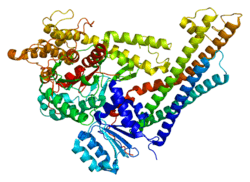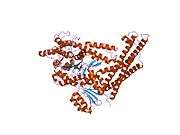STXBP1
Syntaxin-binding protein 1 (also known as Munc18-1) is a protein that in humans is encoded by the STXBP1 gene.[5] This gene encodes a syntaxin-binding protein. The encoded protein appears to play a role in release of neurotransmitters via regulation of syntaxin, a transmembrane attachment protein receptor. Mutations in this gene have been associated with infantile epileptic encephalopathy-4.[6]
Structure
The STXBP1 gene is located on the q arm of chromosome 9 in position 34.11 and has 20 exons spanning 80,510 base pairs.[6] The encoded protein is a peripheral membrane protein located in the cytosol.[7][8] In the retina and cerebellum, an alternatively spliced transcript variant is expressed, containing an additional exon and totaling 603 amino acids.[9] Alternative splicing can produce an isoform with exon 19 and an isoform without.[10][11]
Function
The encoded protein may participate in the regulation of synaptic vesicle docking and fusion, possibly through interaction with GTP-binding proteins. It is essential for neurotransmission and binds syntaxin, a component of the synaptic vesicle fusion machinery probably in a 1:1 ratio. It can interact with syntaxins 1, 2, and 3 but not syntaxin 4 and may play a role in determining the specificity of intracellular fusion reactions.[7][8] This protein functions in a late stage of the intracellular membrane fusion process of exocytosis. Dissociation of this protein from syntaxin determines the kinetics of postfusion events.[12] This protein is essential for presynpatic vesicle release and is rapidly phosphorylated by protein kinase C upon neuronal depolarization.[13] The protein participates in the secretory pathway between the Golgi apparatus and cell membrane.[14][11]
Clinical Significance
Epileptic Encephalopathy
Mutations in the STXBP1 cause Early Infantile Epileptic Encephalopathy Type 4 (EIEE4), a severe form of epilepsy characterized by frequent tonic seizures or spasms beginning in infancy with a specific EEG finding of suppression-burst patterns, characterized by high-voltage bursts alternating with almost flat suppression phases. Affected individuals have neonatal or infantile onset of seizures, profound mental retardation, and MRI evidence of brain hypomyelination. Inheritance of EIEE4 is autosomal dominant.[7][8]
This gene was initially discovered in 2008 as cause for Ohtahara Syndrome. Ever since, it has become one of the most prominent genes for epileptic encephalopathies so far.[15]
Expression
In melanocytic cells STXBP1 gene expression may be regulated by MITF.[16]
The STXBP1 gene is expressed in the brain and spinal cord and highly enriched in axons.[7][8] Expression of this protein is highest in the retina and cerebellum.[9][11]
Interactions
The encoded protein binds SYTL4.[7][8] STXBP1 has been shown to interact with STX2,[17][18] STX4[17][18] and STX1A.[18][19][20][21][22]
External links
References
- GRCh38: Ensembl release 89: ENSG00000136854 - Ensembl, May 2017
- GRCm38: Ensembl release 89: ENSMUSG00000026797 - Ensembl, May 2017
- "Human PubMed Reference:". National Center for Biotechnology Information, U.S. National Library of Medicine.
- "Mouse PubMed Reference:". National Center for Biotechnology Information, U.S. National Library of Medicine.
- Swanson DA, Steel JM, Valle D (March 1998). "Identification and characterization of the human ortholog of rat STXBP1, a protein implicated in vesicle trafficking and neurotransmitter release". Genomics. 48 (3): 373–6. doi:10.1006/geno.1997.5202. PMID 9545644.
- "Entrez Gene: STXBP1 syntaxin binding protein 1". Retrieved 2018-08-29.

- "STXBP1 -Syntaxin-binding protein 1 - Homo sapiens (Human) - STXBP1 gene & protein". www.uniprot.org. Retrieved 2018-08-29.

- "UniProt: the universal protein knowledgebase". Nucleic Acids Research. 45 (D1): D158–D169. January 2017. doi:10.1093/nar/gkw1099. PMC 5210571. PMID 27899622.
- Swanson DA, Steel JM, Valle D (March 1998). "Identification and characterization of the human ortholog of rat STXBP1, a protein implicated in vesicle trafficking and neurotransmitter release". Genomics. 48 (3): 373–6. doi:10.1006/geno.1997.5202. PMID 9545644.
- Hamdan FF, Piton A, Gauthier J, Lortie A, Dubeau F, Dobrzeniecka S, Spiegelman D, Noreau A, Pellerin S, Côté M, Henrion E, Fombonne E, Mottron L, Marineau C, Drapeau P, Lafrenière RG, Lacaille JC, Rouleau GA, Michaud JL (June 2009). "De novo STXBP1 mutations in mental retardation and nonsyndromic epilepsy". Annals of Neurology. 65 (6): 748–53. doi:10.1002/ana.21625. PMID 19557857.
- Online Mendelian Inheritance in Man, OMIM®. Johns Hopkins University, Baltimore, MD. MIM Number: {602926}: {04/22/2014}: . World Wide Web URL: https://omim.org/
- Fisher RJ, Pevsner J, Burgoyne RD (February 2001). "Control of fusion pore dynamics during exocytosis by Munc18". Science. 291 (5505): 875–8. doi:10.1126/science.291.5505.875. PMID 11157167.
- Wierda KD, Toonen RF, de Wit H, Brussaard AB, Verhage M (April 2007). "Interdependence of PKC-dependent and PKC-independent pathways for presynaptic plasticity". Neuron. 54 (2): 275–90. doi:10.1016/j.neuron.2007.04.001. PMID 17442248.
- Pevsner J, Hsu SC, Scheller RH (February 1994). "n-Sec1: a neural-specific syntaxin-binding protein". Proceedings of the National Academy of Sciences of the United States of America. 91 (4): 1445–9. doi:10.1073/pnas.91.4.1445. PMC 43176. PMID 8108429.
- STXBP1 – this is what you need to know in 2015
- Hoek KS, Schlegel NC, Eichhoff OM, Widmer DS, Praetorius C, Einarsson SO, Valgeirsdottir S, Bergsteinsdottir K, Schepsky A, Dummer R, Steingrimsson E (December 2008). "Novel MITF targets identified using a two-step DNA microarray strategy". Pigment Cell & Melanoma Research. 21 (6): 665–76. doi:10.1111/j.1755-148X.2008.00505.x. PMID 19067971.
- Schraw TD, Lemons PP, Dean WL, Whiteheart SW (August 2003). "A role for Sec1/Munc18 proteins in platelet exocytosis". The Biochemical Journal. 374 (Pt 1): 207–17. doi:10.1042/BJ20030610. PMC 1223584. PMID 12773094.
- Hata Y, Südhof TC (June 1995). "A novel ubiquitous form of Munc-18 interacts with multiple syntaxins. Use of the yeast two-hybrid system to study interactions between proteins involved in membrane traffic". The Journal of Biological Chemistry. 270 (22): 13022–8. doi:10.1074/jbc.270.22.13022. PMID 7768895.
- Bhaskar K, Shareef MM, Sharma VM, Shetty AP, Ramamohan Y, Pant HC, Raju TR, Shetty KT (January 2004). "Co-purification and localization of Munc18-1 (p67) and Cdk5 with neuronal cytoskeletal proteins". Neurochemistry International. 44 (1): 35–44. doi:10.1016/S0197-0186(03)00099-8. PMID 12963086.
- Dulubova I, Sugita S, Hill S, Hosaka M, Fernandez I, Südhof TC, Rizo J (August 1999). "A conformational switch in syntaxin during exocytosis: role of munc18". The EMBO Journal. 18 (16): 4372–82. doi:10.1093/emboj/18.16.4372. PMC 1171512. PMID 10449403.
- McMahon HT, Missler M, Li C, Südhof TC (October 1995). "Complexins: cytosolic proteins that regulate SNAP receptor function". Cell. 83 (1): 111–9. doi:10.1016/0092-8674(95)90239-2. PMID 7553862.
- Pérez-Brangulí F, Muhaisen A, Blasi J (June 2002). "Munc 18a binding to syntaxin 1A and 1B isoforms defines its localization at the plasma membrane and blocks SNARE assembly in a three-hybrid system assay". Molecular and Cellular Neurosciences. 20 (2): 169–80. doi:10.1006/mcne.2002.1122. PMID 12093152.
Further reading
- Barcia G, Barnerias C, Rio M, Siquier-Pernet K, Desguerre I, Colleaux L, Munnich A, Rotig A, Nabbout R (December 2013). "A novel mutation in STXBP1 causing epileptic encephalopathy (late onset infantile spasms) with partial respiratory chain complex IV deficiency". European Journal of Medical Genetics. 56 (12): 683–5. doi:10.1016/j.ejmg.2013.09.013. PMID 24095819.
- Garcia EP, McPherson PS, Chilcote TJ, Takei K, De Camilli P (April 1995). "rbSec1A and B colocalize with syntaxin 1 and SNAP-25 throughout the axon, but are not in a stable complex with syntaxin". The Journal of Cell Biology. 129 (1): 105–20. doi:10.1083/jcb.129.1.105. PMC 2120371. PMID 7698978.
- Pevsner J, Hsu SC, Scheller RH (February 1994). "n-Sec1: a neural-specific syntaxin-binding protein". Proceedings of the National Academy of Sciences of the United States of America. 91 (4): 1445–9. doi:10.1073/pnas.91.4.1445. PMC 43176. PMID 8108429.
- Fujita Y, Sasaki T, Fukui K, Kotani H, Kimura T, Hata Y, Südhof TC, Scheller RH, Takai Y (March 1996). "Phosphorylation of Munc-18/n-Sec1/rbSec1 by protein kinase C: its implication in regulating the interaction of Munc-18/n-Sec1/rbSec1 with syntaxin". The Journal of Biological Chemistry. 271 (13): 7265–8. doi:10.1074/jbc.271.13.7265. PMID 8631738.
- Gengyo-Ando K, Kitayama H, Mukaida M, Ikawa Y (November 1996). "A murine neural-specific homolog corrects cholinergic defects in Caenorhabditis elegans unc-18 mutants". The Journal of Neuroscience. 16 (21): 6695–702. doi:10.1523/jneurosci.16-21-06695.1996. PMC 6579271. PMID 8824310.
- Tellam JT, Macaulay SL, McIntosh S, Hewish DR, Ward CW, James DE (March 1997). "Characterization of Munc-18c and syntaxin-4 in 3T3-L1 adipocytes. Putative role in insulin-dependent movement of GLUT-4". The Journal of Biological Chemistry. 272 (10): 6179–86. doi:10.1074/jbc.272.10.6179. PMID 9045631.
- Verhage M, de Vries KJ, Røshol H, Burbach JP, Gispen WH, Südhof TC (March 1997). "DOC2 proteins in rat brain: complementary distribution and proposed function as vesicular adapter proteins in early stages of secretion". Neuron. 18 (3): 453–61. doi:10.1016/S0896-6273(00)81245-3. PMID 9115738.
- Okamoto M, Südhof TC (December 1997). "Mints, Munc18-interacting proteins in synaptic vesicle exocytosis". The Journal of Biological Chemistry. 272 (50): 31459–64. doi:10.1074/jbc.272.50.31459. PMID 9395480.
- Fletcher AI, Shuang R, Giovannucci DR, Zhang L, Bittner MA, Stuenkel EL (February 1999). "Regulation of exocytosis by cyclin-dependent kinase 5 via phosphorylation of Munc18". The Journal of Biological Chemistry. 274 (7): 4027–35. doi:10.1074/jbc.274.7.4027. PMID 9933594.
- Reed GL, Houng AK, Fitzgerald ML (April 1999). "Human platelets contain SNARE proteins and a Sec1p homologue that interacts with syntaxin 4 and is phosphorylated after thrombin activation: implications for platelet secretion". Blood. 93 (8): 2617–26. doi:10.1182/blood.V93.8.2617. PMID 10194441.
- Dulubova I, Sugita S, Hill S, Hosaka M, Fernandez I, Südhof TC, Rizo J (August 1999). "A conformational switch in syntaxin during exocytosis: role of munc18". The EMBO Journal. 18 (16): 4372–82. doi:10.1093/emboj/18.16.4372. PMC 1171512. PMID 10449403.
- Misura KM, Scheller RH, Weis WI (March 2000). "Three-dimensional structure of the neuronal-Sec1-syntaxin 1a complex". Nature. 404 (6776): 355–62. doi:10.1038/35006120. PMID 10746715.
- Allan BB, Moyer BD, Balch WE (July 2000). "Rab1 recruitment of p115 into a cis-SNARE complex: programming budding COPII vesicles for fusion". Science. 289 (5478): 444–8. doi:10.1126/science.289.5478.444. PMID 10903204.
- Shorter J, Beard MB, Seemann J, Dirac-Svejstrup AB, Warren G (April 2002). "Sequential tethering of Golgins and catalysis of SNAREpin assembly by the vesicle-tethering protein p115". The Journal of Cell Biology. 157 (1): 45–62. doi:10.1083/jcb.200112127. PMC 2173270. PMID 11927603.
- Ho CS, Marinescu V, Steinhilb ML, Gaut JR, Turner RS, Stuenkel EL (July 2002). "Synergistic effects of Munc18a and X11 proteins on amyloid precursor protein metabolism". The Journal of Biological Chemistry. 277 (30): 27021–8. doi:10.1074/jbc.M201823200. PMID 12016213.
- Pérez-Brangulí F, Muhaisen A, Blasi J (June 2002). "Munc 18a binding to syntaxin 1A and 1B isoforms defines its localization at the plasma membrane and blocks SNARE assembly in a three-hybrid system assay". Molecular and Cellular Neurosciences. 20 (2): 169–80. doi:10.1006/mcne.2002.1122. PMID 12093152.
- Barclay JW, Craig TJ, Fisher RJ, Ciufo LF, Evans GJ, Morgan A, Burgoyne RD (March 2003). "Phosphorylation of Munc18 by protein kinase C regulates the kinetics of exocytosis". The Journal of Biological Chemistry. 278 (12): 10538–45. doi:10.1074/jbc.M211114200. PMID 12519779.
- Fukuda M (April 2003). "Slp4-a/granuphilin-a inhibits dense-core vesicle exocytosis through interaction with the GDP-bound form of Rab27A in PC12 cells". The Journal of Biological Chemistry. 278 (17): 15390–6. doi:10.1074/jbc.M213090200. PMID 12590134.
- Craig TJ, Evans GJ, Morgan A (September 2003). "Physiological regulation of Munc18/nSec1 phosphorylation on serine-313". Journal of Neurochemistry. 86 (6): 1450–7. doi:10.1046/j.1471-4159.2003.01955.x. PMID 12950453.
This article incorporates text from the United States National Library of Medicine, which is in the public domain.






